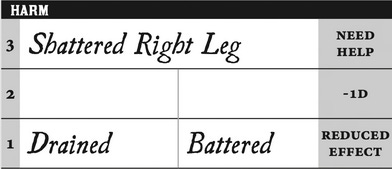Three Nine Dispatch #43
Whiling away the owers.
Did a pretty good chunk of work this week. I have a little/easy update to Steam Thieves. But I also have some very neat (and original!) stuff down for Sand & Stars.
It was a lot of fun to create, as opposed to copy. That process has me putting S&S top of my priorities, for now.
Project Run down
Sand & Stars
(Desert survival x Cairn, Ashcan here [link])
I love mixing mechanics with world-building. I’m trying to really mesh those together in this project. Nowhere is that more obvious than in my systems for tracking time, distance and water consumption.
Below is my time tracking system. Now, it’s very cute. Maybe too cute. But I get kinda irked when a fantasy setting has made up words for most things but not units of measurement (which, in our world, have a rich history behind what they’re called and how much they measure). I was reminded of this when reading The Name of the Rose by Umberto Ecco (which I loved, by the way - top five novel for me). Ecco made the mistake of including ‘seconds’ in his prose, despite that measurement not being invented in the time he set his story (1327).
In this game I’ve come up with something quite sneaky (and as I said before ‘cute’) for measuring time in a way that is both fanciful and functional. I really like it.
I also have my moon system for measuring days and nights. This is also fanciful and functional. This game is designed for point crawls and I imagine the GM telling players which moon has risen and then they plot whether they will cross the open terrain during that moon or stay in shelter.
Anyways, check ‘em out.
…
In the Desert, time is measured in owers.
An ower was a great clay vase with a narrow neck, which was commonly used to dispense water during large gatherings. An ower was designed to hold enough water to fill sixty drinking glasses, known then as minits. It was traditional to fill a minit with sixty drips (known as sekkons) from the ower.
A sekkon became a way of measuring time, roughly equating the passage of time needed for a sekkon to drip from an ower and land in a minit. A minit is the time it takes for said minit to be filled with sekkons. And an ower is the time it would take for a filled ower to run entirely dry.
Days and nights are measured in belts.
A belt is comprised of around four owers. Each belt is marked by the unique moon/s that regularly cross the cloudless sky. The Great Sun beats down on the Desert for four consecutive Belts each day. This is followed by four consecutive Belts of night.
During the day red moons cross over the desert. The first of them is the Child. This is followed by the Fool, then the Judge and the Hangman.
The Great Sun sets during the Hangman’s Moon. This ushers in the white moons that rise and fall in the dark.
After the Great Sun is set, the first moon to appear is The Weeping Moon. This is followed by the Mouse, then the Snake and finally The Lovers.
The Great Sun always rises as the Child passes over The Lovers.
The Desert conditions are most hospitable when The Lovers, The Child, The Hangman or The Weeping Moon is present.
Steam Thieves
(Steampunk x Forged in the Dark, Ashcan here [link])
Just a quick copy and paste job.
…
Harm
This consequence represents a long-lasting debility (or death). When you suffer harm, record the specific injury on your character sheet equal to the level of harm you suffer. If you suffer lesser harm, record it in the bottom row. If you suffer moderate harm, write it in the middle row. If you suffer severe harm, record it in the top row. See examples of harm and the harm tracker, below.
Your character suffers the penalty indicated at the end of the row if any or all harm recorded in that row applies to the situation at hand. So, if you have “Drained” and “Battered” harm in the bottom row, you’ll suffer reduced effect when you try to run away from the coppers. When you’re impaired by harm in the top row (severe harm, level 3), your character is incapacitated and can’t do anything unless you have help from someone else or push yourself to perform the action.
If you need to mark a harm level, but the row is already filled, the harm moves up to the next row above. So, if you suffered standard harm (level 2) but had no empty spaces in the second row, you’d have to record severe harm (level 3), instead. If you run out of spaces on the top row and need to mark harm there, your character suffers a catastrophic, permanent consequence (loss of a limb, sudden death, etc., depending on the circumstances).
This character has three harm: a “Shattered Right Leg” (level 3) plus “Drained” and “Battered” (level 1). If they suffer another level 1 harm, it will move up to level 2. If they suffer another level 3 harm, it will move up to level 4: Fatal.
Harm Examples
Fatal (4): Electrocuted, Drowned, Stabbed in the Heart.
Severe (3): Impaled, Broken Leg, Shot in Chest, Badly Burned, Terrified.
Moderate (2): Exhausted, Deep Cut to Arm, Concussion, Panicked, Seduced.
Lesser (1): Battered, Drained, Distracted, Scared, Confused.
Harm like “Drained” or “Exhausted” can be a good fallback consequence if there’s nothing else threatening Steam Thieves (like when they spend all night Studying schematics, looking for any clues to their enemy’s weaknesses before they strike).
Goodnight Maus
(Mausritter adventure site inspired by Goodnight Moon)
…
No progress.
Trinakum
(Original design - 3d6 dice pool/grid-based/combat simulator with Iron Age Celtic/Gaulish flavour, Ashcan here [link])
…
No progress.
Note: Need to put this into a Scrivener doc, too.
Gatekeepers
(Mythos inspired Breathless game for the Beyond the Gates Jam, Ashcan here [link])
…
No progress.
WAKE
(Completed Breathless game inspired by Control, Inception and The Matrix, Game Page here [link])
…
No progress.




